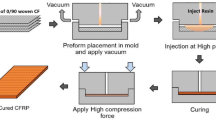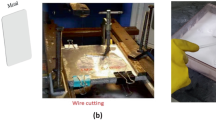Abstract
This article, through an industrial-level case study, presents workflows employed for decision-making to mitigate cracking of glass fibre reinforced polymer (GFRP) parts in tight radii corner locations, often resulting from displacement-controlled de-moulding processes. Namely, using process simulation to evaluate the cure cycle of the GFRP composite parts, it was possible to optimize the time of de-moulding and reduce the potential for part damage. It was observed that the most significant factors influencing the corner defect were boundary conditions of the part during de-moulding, the workshop temperature and part thickness. The poorest process design case was identified as hot workshop temperature, a laminate with thickness on the upper end of tolerances and a boundary condition where most sides are free, allowing for the development of larger moment forces at the tight corners. Further to this, a de-moulding time chart was developed to account for the changes in material properties as a function of temperature and material thickness, allowing for the in situ decision-making of technicians to reduce the occurrence of corner cracks.
















Similar content being viewed by others
References
Strong BA (2008) Fundamentals of composites manufacturing: materials, methods and applications, 2nd edn. Society of Manufacturing Engineers, Dearborn
Robert IM (2001) Fibre Reinforced Polymers – From Aerospace to Infrastructure, ATSE Focus, No. 107
Cunningham J (2015) The difficulty of qualifying exotic materials and processes for flight. Engineering Materials. http://www.materialsforengineering.co.uk. Accessed 06 Mar 2020
Mazumdar SK (2002) Composites manufacturing, materials, product and process engineering, 2nd edn. CRC Press, Boca Raton
Khan MA, Kumar AS, Poomari A (2012) A hybrid algorithm to optimize cutting parameter for machining GFRP composite using alumina cutting tools. Intl J Adv Manuf Tech 59:1047–1056
Huang Y, Liu S, Xiao G, He Y, Wang W (2020) Experimental investigation into the effects of adhesion wear on belt grinding of glass fiber reinforced plastics. Intl J Adv Manuf Tech 109:463–473
Torres J (2015) Effect of geometrical and process parameters on the quality of open moulded composite parts with sharp corners: a decision-based approach. Dissertation, University of British Columbia
Convergent Manufacturing Technologies Inc. (2020) RAVEN Simulation Software. https://www.convergent.ca/products/raven-simulation-software. Accessed 20 Apr 2020
Shimizu T, Kotlik JC, Arafath ARA, Poursartip A (2008) Evaluation of temperature profiles in thick composite parts during autoclave processing. Proceedings of 23rd ASC Technical Conference:1–17
Shah Mohammadi M, Solnickova L, Crawford B, Komeili M, Milani AS (2014) Investigating the unrecovered displacement of glass fibre reinforced polymers due to manufacturing conditions. J Multifunctional Compos 2:100–104
Guidelines for property testing of composites. In: CMH-17 Composite Materials Handbook – Revision G Volume 1. SAE International, Wichita, pp 82–203
Baran I, Cinar K, Ersoy N, Akkerman R, Hattel J (2017) A review on the mechanical modeling of composite manufacturing processes. Arch Comput Methods Eng 24:365–395
Thorpe R (2013) Experimental characterization of the viscoelastic behavior of a curing epoxy matrix composite from pre-gelation to full cure. Dissertation, University of British Columbia
Scott Bader (2020) Crystic gelcoat 44PA – sandable spray gelcoat. https://www.scottbader.com/wp-content/uploads/4006_crystic-gelcoat-44pa-gelcoat-en-feb13.pdf. Accessed 15 Apr 2020
Fernlund G, Floyd A, McKay S (2007) Process analysis and tool compensation for curved composite L-angles. Proceedings of the 6th international conference on composite materials (ICCM)
Fernlund G, Floyd A, Shewfelt M, Hudek M (2007) Process analysis and tool compensation for a complex composite panel. In proceedings of the 6th international conference on composite materials (ICCM)
Twigg G (2001) Tool-part interaction in composites processing. Dissertation, University of British Columbia
White S, Hahn H (1993) Cure cycle optimization for the reduction of processing-induced residual stresses in composite materials. J Compos Mater 27(14):1352–1378
Bogetti TA, Gillespie JW (1992) Process-induced stress and deformation in thick-section thermoset composite laminates. J Compos Mater 26(5):626–660
Cole KC, Hechler JJ, Noël D (1991) A new approach to modeling the cure kinetics of epoxy/amine thermosetting resins. 2. Application to a typical system based on bis[4-(diglycidylamino)phenyl]methane and bis(4-aminophenyl) sulfone. Macromolecules 24(11):3027–3468
Fernlund G, Poursartip A, Twigg G, Albert C (2003) Residual stress, spring-in and warpage in autoclaved composite parts. Proceedings of the 4th international conference on composite materials (ICCM)
Zhao L, Warrior N, Long A (2007) A thermo-viscoelastic analysis of process-induced residual stress in fiber-reinforced polymer-matrix composites. Mater Sci Eng A 452:483–498
Author information
Authors and Affiliations
Corresponding author
Additional information
Publisher’s note
Springer Nature remains neutral with regard to jurisdictional claims in published maps and institutional affiliations.
Appendix: a closer look to the effect of resin curing
Appendix: a closer look to the effect of resin curing
The development of the resin modulus throughout the manufacturing process primarily influences the bulk mechanical properties of the composite laminate prior to de-moulding. Specifically, once the initiator compound is added to the resin mix, the generation of free radical particles begins and chemical bonding between monomers into long polymer chains begins, as depicted in Fig. 17.
As the chains grow longer with more monomers added, the overall mobility of the molecules diminishes, and bulk rigidity becomes higher. This leads to an eventual transition from a liquid into a solid state, which becomes glassy as the available mobility effectively reduces to zero. Similarly, as this progresses, so does the measurable modulus of the material. Figure 18 shows both an example relationship between a cure temperature, degree of cure and glass transition temperature of an unsaturated polyester resin and the generic relationship between degree of cure and developed elastic modulus.
It is important to note that the cure process is dependent on not only temperature but also time, as the chemical reaction has many factors that make the timescale great enough for de-moulding activities to take place during material property changes. The development of cure and hence material properties can be modelled in many ways, typically done empirically using a differential scanning calorimeter (DSC) and then curve-fitting the results to an assumed phenomenological model. There are many that have been developed for particular material systems, each with their own mechanics. For a chemical system with a heavy dependence on diffusion-based mechanisms, Cole et al. [20] developed Eq. (4) shown below, which has been effective in other published works [19].
where α is the degree of cure, K describes the Arrhenius function for the reaction, αC0 is the critical degree of cure at T = 0 K, αCT is a constant accounting for increase in critical resin degree of cure with temperature and m and n are constants obtained from a curve-fitting analysis.
Rights and permissions
About this article
Cite this article
Crawford, B.J., Torres, J. & Milani, A.S. Minimizing corner cracking during the de-moulding process of industrial-size GFRP components: a case study. Int J Adv Manuf Technol 111, 711–723 (2020). https://doi.org/10.1007/s00170-020-06141-9
Received:
Accepted:
Published:
Issue Date:
DOI: https://doi.org/10.1007/s00170-020-06141-9






